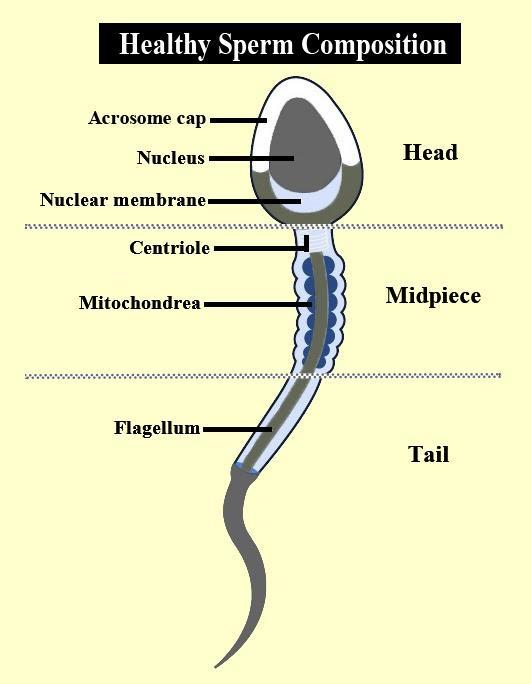
The given diagram shows a human cell this cell is produced in the

A. Ovary
B. Sperm ducts
C. Oviducts
D. Testes

Answer
393.9k+ views
Hint: Reproduction is a fundamental biological process by which offspring are produced from their parents. Sexual reproduction involves the fusion of male and female gametes to produce a new individual. Sexual reproductions cause changes in the number of chromosomes. Asexual reproduction does not involve the fusion of male and female gametes and changes in the chromosomal number.
Complete answer:
The male reproductive system includes the testicles, the duct system, accessory glands such as seminal vesicles and prostate glands, and the penis. The above diagram is of a sperm cell that is produced by the testes.
The testicles also produce a hormone known as testosterone that stimulates the production of the sperm cell. Testicles are present in a pouch-like structure known as the scrotum. The scrotum hangs down to maintain a cooler temperature than the body temperature for the feasible production of sperm. Epididymis and vas deferens are also present alongside testicles.
Seminal vesicles and prostate glands secrete fluids to lubricate the duct system and provide nourishment to the sperm cells. The urethra carries the sperm outside of the body through the penis. The penis is made up of two parts known as the shaft and glans.
The shaft is the mid part of the penis and the glans is the tip that has a small slit from where the sperms and the pee exit from the body. The penis is made up of spongy tissue that can expand and contract.
Therefore the correct answer is option D.
Note:
The process by which haploid gametes, the sperm from the male, and the egg cell from the female are fused to form a zygote is known as fertilization. Fertilization results with a diploid zygote that can be achieved both naturally or by assisted reproductive technologies (ART).
Complete answer:
The male reproductive system includes the testicles, the duct system, accessory glands such as seminal vesicles and prostate glands, and the penis. The above diagram is of a sperm cell that is produced by the testes.
The testicles also produce a hormone known as testosterone that stimulates the production of the sperm cell. Testicles are present in a pouch-like structure known as the scrotum. The scrotum hangs down to maintain a cooler temperature than the body temperature for the feasible production of sperm. Epididymis and vas deferens are also present alongside testicles.
Seminal vesicles and prostate glands secrete fluids to lubricate the duct system and provide nourishment to the sperm cells. The urethra carries the sperm outside of the body through the penis. The penis is made up of two parts known as the shaft and glans.
The shaft is the mid part of the penis and the glans is the tip that has a small slit from where the sperms and the pee exit from the body. The penis is made up of spongy tissue that can expand and contract.
Therefore the correct answer is option D.
Note:
The process by which haploid gametes, the sperm from the male, and the egg cell from the female are fused to form a zygote is known as fertilization. Fertilization results with a diploid zygote that can be achieved both naturally or by assisted reproductive technologies (ART).
Recently Updated Pages
Master Class 11 Accountancy: Engaging Questions & Answers for Success

Glucose when reduced with HI and red Phosphorus gives class 11 chemistry CBSE

The highest possible oxidation states of Uranium and class 11 chemistry CBSE

Find the value of x if the mode of the following data class 11 maths CBSE

Which of the following can be used in the Friedel Crafts class 11 chemistry CBSE

A sphere of mass 40 kg is attracted by a second sphere class 11 physics CBSE

Trending doubts
10 examples of friction in our daily life

Difference Between Prokaryotic Cells and Eukaryotic Cells

One Metric ton is equal to kg A 10000 B 1000 C 100 class 11 physics CBSE

State and prove Bernoullis theorem class 11 physics CBSE

What organs are located on the left side of your body class 11 biology CBSE

Define least count of vernier callipers How do you class 11 physics CBSE




